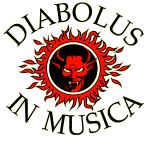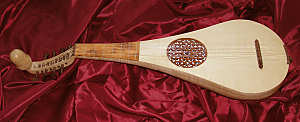 |
The Gittern and Citole |
The Citole was largely a pre-1400 phenomenon. It is generally shown as a four-string instrument, with a body generally referred to as "holly-leaf" shaped. There is, amazingly, a surviving instrument from around 1300, which was originally owned by the earls of Warwick, but is now in the British Museum, probably still labelled as the "Warwick Castle Gittern". This example survived because it was a nobleman's instrument, and every inch of the body is covered in very fine carving. Being an heirloom and a thing of beauty, it was converted into a violin in the sixteenth century and given a new life, instead of being consigned to the firewood pile. Instrument makers like us may curse at the loss of information about the original soundboard construction, but at least we have an authentic body, and don't have to rely entirely on crabby medieval illustrations and buckets of conjecture. The body and neck are carved from a single lump of wood, and the neck is very deep, having a hole pierced through it for the player's thumb. The gittern resembles a very small lute, with a curved ("sickle-shaped") pegbox. The body of the lute was always built up from a number of thin, tapered ribs, joined at the edges to form the characteristic rounded shape, with the solid neck attached as a separate piece. The gittern, by contrast, was carved from a single piece of wood, like the citole. There is a surviving gittern, a very fine example by Hans Oth of Nuremberg, dated about 1450. This is a late gittern, having five double-strung courses, and it may be a gittern trying to be a treble lute, reflecting changing musical ideas and playing styles. Illustrations suggest that four courses were more usual, and the gittern was probably single-strung before about 1400. The citole has been proposed as the ancestor of the renaissance cittern, largely, it seems, from the association of both instruments with commoners and "low" musical situations. Since the cittern was strung in metal, modern citole reconstructions are often metal-strung also. I have to say that this is based on pure conjecture. What evidence there is suggests that the only metal-strung instruments in the middle ages were the psaltery, dulcimer and the Irish harp. There is definite documentary evidence that both the citole and the gittern were normally strung in gut. Finally, another point of confusion. The name "citole" died out with the instrument, in around 1400, unless you think that "cittern" is a derivation of it. "Gittern", on the other hand, carried on, and seems to have been applied haphazardly to whatever plucked string instrument happened to be in fashion, if it wasn't a lute. So the early guitar was called a gittern in the early sixteenth century. By the eighteenth, the gittern was a form of English guitar, which wasn't a guitar, but a form of cittern. Aren't you glad you don't do research into early instruments? On the other hand, we're just as bad nowadays. Spare a thought for the poor music researcher four centuries hence who has to sort out the terms acoustic, Les Paul, jazz, Spanish, electro-acoustic, steel, Fender, bass, guitar synth, plank, classical, Strat, twelve-string, and a few others, all of which are either minor variants or completely different instruments, but all called guitars. Note: a new and possibly definitive book on the history of all the European plucked strings has recently been published. Details under Guitar in this guide. |
 Diabolus Homepage |
 Look up another Instrument |
 Email for Diabolus |
